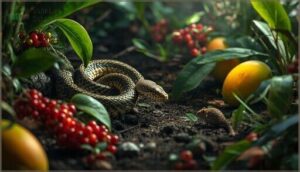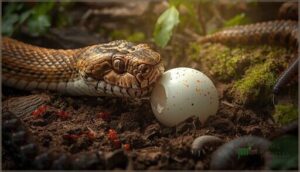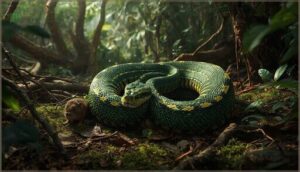This site is supported by our readers. We may earn a commission, at no cost to you, if you purchase through links.

Snakes don’t nibble or graze—they’re pure predators, built from the ground up to hunt and devour other animals. Every species, from the tiniest thread snake to massive anacondas, survives exclusively on animal tissue. This carnivorous commitment shapes everything about them: their hunting strategies, jaw mechanics, digestive systems, and even how often they need to eat.
What ends up on the menu varies dramatically depending on size, habitat, and species. A garter snake in your backyard targets earthworms and amphibians, while a python in Southeast Asia might take down a deer.
Understanding what snakes eat—and how they do it—reveals the striking adaptations that make these legless hunters so successful across nearly every habitat on Earth.
Table Of Contents
- Key Takeaways
- What Do Snakes Eat?
- Do Snakes Eat Fruit or Plants?
- Types of Prey Consumed by Snakes
- How Snakes Hunt and Eat Their Food
- Snake Diet Variations by Species and Age
- Feeding Pet Snakes: Best Practices
- Frequently Asked Questions (FAQs)
- What animals do snakes typically eat?
- What insects do snakes typically eat?
- Are there any animals that snakes do not eat?
- Do snakes eat other snakes?
- What foods do snakes eat?
- Will a snake eat a cockroach?
- Will a snake eat a squirrel?
- What does a snake eat in 30 words?
- What kind of food do snakes eat?
- Do snakes eat fruit?
- Conclusion
Key Takeaways
- Every snake species is an obligate carnivore with digestive systems exclusively designed to process animal tissue, lacking the enzymes needed to break down plant matter or carbohydrates of any kind.
- Snake prey selection varies dramatically by species and size, ranging from termite eggs consumed by thread snakes to deer and jaguars hunted by large constrictors like anacondas and pythons.
- Snakes employ two primary hunting strategies—venomous species deliver rapid strikes with toxin injection, while constrictors use coiled pressure to induce cardiac arrest—both methods proving highly energy-efficient for capturing prey.
- Pet snake care requires feeding appropriately sized frozen or prekilled prey on species-specific schedules (juveniles every 5-7 days, adults every 1-4 weeks), while avoiding toxic foods, wild-caught animals, and live prey that pose injury risks.
What Do Snakes Eat?
Snakes are strict carnivores, meaning they only eat other animals to survive. Their diet varies widely depending on the species, size, and habitat they live in.
Let’s look at what snakes usually hunt in the wild, why they’re built to be meat-eaters, and how different species have adapted to eat different prey.
Typical Prey in The Wild
In the wild, you’ll find snakes targeting a wide range of prey depending on their size and habitat. Wild snakes hunt rodent populations like mice and rats, engage in bird predation by raiding nests, and consume reptiles including lizards.
Amphibian diets feature frogs and toads, while smaller species rely heavily on insect prey such as crickets and earthworms for their nutritional needs. Snakes are carnivores, and their prey size varies considerably.
Carnivorous Nature of Snakes
Snakes are obligate carnivores, meaning they’ve evolved to survive exclusively on animal prey. Their digestive enzymes are specifically designed to break down proteins and fats, not plant matter. When offered fruits or vegetables, snakes exhibit complete plant rejection—they simply won’t eat them.
Snakes are obligate carnivores with digestive systems built exclusively for meat, not plants
Snakes are obligate carnivores with digestive systems built exclusively for meat, not plants
Snakes survive solely on animal prey because their bodies are designed to digest meat, not plants
Over 90 million years of evolutionary history has shaped their bodies to extract energy sources solely from other animals, making a carnivorous diet non-negotiable for their survival. In Florida, invasive Burmese pythons demonstrate this by consuming large prey, such as deer and alligators.
Differences in Diet by Species
While all snakes are carnivores, diet specialization varies dramatically across snake species. Queen Snakes target recently molted crayfish, while Mud Snakes hunt aquatic salamanders almost exclusively.
These snake dietary preferences often correlate with morphological adaptations—Hog-nosed Snakes developed upturned noses for excavating toads, their preferred snake prey.
Infraorder diets also differ: Brahminy Blind Snakes consume termites and ants, whereas more-developed species generally pursue larger mammals and amphibians.
Do Snakes Eat Fruit or Plants?
You might wonder if snakes occasionally snack on berries or nibble on leaves like some other reptiles do. The answer is a definitive no—snakes are strict carnivores that can’t process plant material at all.
Their bodies simply aren’t built for it, and understanding why reveals a lot about how these fascinating predators survive.
Digestive System Limitations
The digestive tract of snakes is built for meat, not salad. Their anatomy reveals why fruits and plants won’t work:
- Enzyme deficiencies: Snakes lack amylase and other plant-digesting enzymes, making carbohydrate breakdown impossible.
- Intestinal morphology: Their short, narrow intestines are optimized for infrequent, large meals rather than processing fibrous plant matter.
- Absorption constraints: Snake digestion extracts nutrients exclusively from animal tissues, not vegetation.
Why Snakes Avoid Plant Matter
Beyond digestive limitations, behavioral and evolutionary forces keep snakes away from plants. Their carnivorous classification reflects millions of years of specialized predation, not herbivory. You’ll notice snakes drawn to vegetation indirectly—they’re hunting prey, not sampling foliage.
| Snake Diet Considerations | Reptile Diet Reality | Plant Interaction |
|---|---|---|
| Evolutionary Carnivory | Obligate meat-eaters | Prey Attraction only |
| Digestive Limitations | No plant enzymes | Accidental Ingestion risks |
| Plant Repellents | Avoid strong scents | Behavioral avoidance |
Types of Prey Consumed by Snakes
Snakes are opportunistic hunters that consume a wide variety of prey depending on their size, habitat, and species. Their diet ranges from tiny invertebrates to large mammals, with most species targeting vertebrate animals as their primary food source.
Let’s look at the main categories of prey that different snakes consume in the wild.
Mammals and Birds
You’ll find that rodents make up the lion’s share of what many snakes eat, accounting for nearly a third of prey items in some species. Birds represent another important food source at around 11-18% of their diet.
These warm-blooded prey animals became dietary staples after snakes evolved specialized hunting behavior to track mammals and raid avian nesting sites during the Eocene period.
Reptiles and Amphibians
Beyond mammals and birds, reptiles and amphibians form a surprisingly large part of many snake diets. In some populations, these cold-blooded prey make up 60% of what snakes consume. You’ll find fascinating dietary specialization among:
- Kingsnakes with venom immunity to safely eat venomous snakes
- Kukri snakes displaying evisceration behavior on frogs
- Mussurana snakes feeding almost exclusively on other snakes
- Semi-aquatic species benefiting from habitat overlap with amphibians
- Generalist predators where snakes contribute 24% of total prey biomass
This reptilian diet provides substantial energy despite regional variation.
Eggs and Invertebrates
You might be surprised to learn that eggs and invertebrates played a key role in snake evolution—the earliest snakes were insectivorous, feeding exclusively on insects before vertebrate diets emerged.
Today, specialized species like Dasypeltis consume only bird eggs, while blind snakes still feed on ants and termites. Other snakes target earthworms, slugs, and heavily defended prey like centipedes, reflecting diverse dietary shifts across lineages.
Large Prey for Bigger Snakes
When you encounter a large python or anaconda, you’re looking at a predator whose gape limitations allow it to swallow deer, capybaras, and even monkeys. Burmese pythons can consume prey weighing up to 67% of their body mass—sometimes deer exceeding 77 pounds.
Large pythons and anacondas can swallow prey like deer and capybaras weighing up to 67% of their own body mass
Large pythons can consume prey weighing up to two-thirds of their body mass, including deer and capybaras
Large pythons can swallow prey weighing up to two-thirds of their own body mass, including deer and capybaras
Large pythons can consume prey weighing up to two-thirds of their own body mass, including deer and capybaras
Large pythons can swallow prey weighing up to two-thirds of their own body mass, including deer and capybaras
Large pythons can swallow prey like deer weighing up to two-thirds of their own body mass
Large pythons and anacondas can swallow prey like deer and capybaras weighing up to 67% of their own body mass
Large pythons can swallow prey weighing up to two-thirds of their own body mass, including deer and capybaras
Large pythons can swallow prey weighing up to two-thirds of their own body mass, including deer and capybaras
Large pythons and anacondas can swallow prey like deer and capybaras weighing up to 67% of their own body mass
Large pythons can swallow prey weighing up to two-thirds of their own body mass, including deer and capybaras
Invasive pythons in Florida demonstrate the ecological impact of these feeding abilities, with digestion rates allowing them to process massive meals over weeks.
How Snakes Hunt and Eat Their Food
Snakes have evolved striking strategies to capture and consume prey without the benefit of limbs or chewing ability. Whether through venom or constriction, each species has adapted its hunting technique to match its environment and preferred food source.
Understanding how these predators locate, subdue, and digest their meals reveals the intricate biology behind their carnivorous lifestyle.
Venomous Vs. Constrictor Techniques
Snakes use two primary hunting techniques that reveal nature’s elegant problem-solving. Venomous species deliver rapid strikes exceeding 4.5 meters per second, injecting potent toxins to immobilize prey within minutes. Constrictors like boas and pythons take a different approach:
- Striking to secure prey with backward-curved teeth
- Coiling around the target’s body
- Applying steady pressure until cardiac arrest occurs
Both methods demonstrate considerable energy efficiency in prey selection.
Sensory Adaptations for Finding Prey
Before striking, you’ll notice snakes rely on impressive sensory systems to locate their next meal. Pit vipers detect body heat through infrared detection using specialized pit organs, pinpointing warm-blooded prey up to one meter away.
Their tongues constantly flick outward for chemical sensing, delivering scent particles to the Jacobson’s organ for analysis.
Some species combine visual acuity with mechanoreception—sensing vibrations through their scales—creating sensory integration that makes them extraordinarily effective hunters.
Swallowing and Digestion Process
Once they’ve located prey, jaw mechanics take over—flexible tendons and elastic ligaments let snakes swallow animals several times wider than their own head. Their independent jawbones work without chewing, moving prey inward using specialized teeth.
Then gastric acid drops stomach pH to 2 within a day, while enzymatic breakdown dissolves tissues and bone. Digestion duration ranges from three days to two weeks, depending on meal size.
Snake Diet Variations by Species and Age
Not all snakes eat the same things. What ends up on the menu depends largely on the species and the snake’s age, with baby snakes often starting small and adults tackling much larger prey.
Let’s look at how diet shifts across different snake types and life stages.
Baby Snake Diets (Species-Specific)
When hatchlings emerge, their first meals depend heavily on species and habitat. Baby snakes start small but have surprisingly specific tastes shaped by evolution and environment.
- Baby corn snakes hunt frogs, earthworms, and small rodents in fields and forests
- Baby garter snakes prefer tadpoles, fish eggs, and tiny amphibians near water
- Baby rattlesnakes consume insects and lizards before graduating to mice
- Baby copperheads use tail-luring to catch salamanders and frogs
Common U.S. Snake Diets
Across U.S. regions, you’ll find snakes with overlapping diets shaped by local prey availability. Most terrestrial species—like rattlesnakes, king snakes, and rat snakes—rely heavily on rodents, which make up roughly 80% of their diet. Birds, lizards, amphibians, and even other snakes round out the menu.
Urban environments and invasive species introduce new prey options, while seasonal variation shifts hunting patterns as temperatures and prey activity fluctuate throughout the year.
Unique Diets of Smallest and Largest Snakes
At the extremes of snake size, you’ll find striking feeding adaptations. The Barbados thread snake targets ant and termite eggs—prey tiny enough for its pencil-lead-thin body. Meanwhile, green anacondas tackle jaguars, deer, and caimans weighing as much as they do.
This prey size ratio directly reflects habitat influence: underground dwellers consume insects, while powerful aquatic constrictors ambush large mammals in marshes.
Feeding Pet Snakes: Best Practices
Feeding a pet snake isn’t quite like feeding a dog or cat—you’ll need to think about the type of prey, how often to feed, and what foods could actually harm your snake. Getting these basics right makes a real difference in keeping your snake healthy and thriving.
Let’s walk through the key practices every snake owner should follow.
Live Vs. Frozen Prey
When feeding snakes, you’ll face the live vs frozen prey debate. Frozen prey is safer—live rodents can bite or scratch your snake, causing serious wounds. Nutritional value remains comparable between both options, though frozen eliminates disease risks like parasites.
While live prey stimulates hunting behavior, most experts recommend prekilled food for safety.
Ethical considerations matter too, as frozen prey avoids unnecessary animal suffering during feeding.
Feeding Frequency and Portion Size
Your snake’s feeding frequency depends on several factors. Juvenile snakes generally need meals every 5–7 days due to higher metabolic influence and caloric needs, while adults eat every 1–4 weeks.
Age variations matter—baby ball pythons require weekly feedings, but adults do fine biweekly. Prey size should match your snake’s girth, and seasonal effects can shift appetite, making balanced snake diet adjustments essential year-round.
Foods to Avoid for Snake Health
You’ll want to steer clear of foods that pose toxic prey risks or create nutritional imbalance. Indigestible foods and chemical risks from wild-caught animals can devastate your snake’s health, while pathogen risks from contaminated prey cause serious illness. Following proper snake feeding guidelines protects your pet’s well-being.
- Avocados, citrus fruits, onions, and garlic cause gastrointestinal distress and organ damage in reptiles
- Wild-caught prey may carry pesticides, parasites, and bacterial pathogens like Salmonella
- Live prey injures snakes in up to 12% of feeding incidents
- Fish-based diets induce thiamine deficiency, leading to neurological dysfunction within weeks
- Fruits, vegetables, and processed foods remain indigestible and cause impaction or pancreatitis
Proper snake diet and nutrition means offering whole, commercially bred prey items. Vitamin supplementation for snakes becomes necessary when nutrient degradation occurs in prey frozen longer than six months. A balanced snake diet avoids these hazards entirely, keeping your snake thriving.
Frequently Asked Questions (FAQs)
What animals do snakes typically eat?
Snakes generally eat small mammals like mice, rats, and rabbits, along with birds, reptiles, amphibians, fish, eggs, and invertebrates. Larger species consume bigger prey, including deer, pigs, and even jaguars, depending on their size.
Their flexible jaws allow them to swallow large prey whole.
What insects do snakes typically eat?
Surprisingly, smaller snake species and juveniles rely heavily on insects as small prey—think crickets, grasshoppers, beetles, and ants. Insectivorous snakes like rough green snakes consume these regularly, with juvenile snake diets shifting as they mature.
These snakes play a crucial role in the ecosystem.
Are there any animals that snakes do not eat?
Yes—toxic prey like certain frogs, animals with venom resistance (mongooses, honey badgers), and those exceeding gape limits are avoided.
Husbandry guidance also excludes plants, processed foods, and prey outside documented dietary preferences.
Do snakes eat other snakes?
Yes, ophiophagy—the eating of other snakes—occurs across at least 52 species worldwide.
King cobras feed primarily on snake prey, while kingsnakes regularly consume rattlesnakes and other species, sometimes even practicing cannibalistic feeding habits.
What foods do snakes eat?
Picture a king cobra zeroing in on a rat snake—yes, some snakes eat other snakes.
Wild snake diets include mammals, birds, reptiles, amphibians, fish, and invertebrates, providing essential prey nutritional value.
Will a snake eat a cockroach?
Some smaller insectivorous snakes, like rough green snakes and ringneck snakes, will eat cockroaches in the wild.
However, most pet snakes won’t recognize roaches as prey, and pesticide risks make wild-caught insects unsuitable for captive feeding.
Will a snake eat a squirrel?
Absolutely—many snake species eat squirrels, especially rattlesnakes. Timber rattlesnakes favor Eastern gray squirrels, while California ground squirrels often fall prey to Pacific rattlesnakes.
Juvenile squirrels face greater predation risk than venom-resistant adults.
What does a snake eat in 30 words?
You’re what you eat—true for snakes too. Snakes consume whole animals like rodents, birds, frogs, lizards, and eggs exclusively.
Dietary preferences vary by species, with prey variety meeting their complete nutritional needs as obligate carnivores.
What kind of food do snakes eat?
Snakes eat only animal-based foods—never plants. Their diet includes rodents, birds, reptiles, amphibians, fish, eggs, and invertebrates.
Dietary specialization varies by species, with prey nutritional value driving their highly efficient digestion.
Do snakes eat fruit?
You might spot a snake near fallen apples and wonder if it’s snacking on fruit. The answer is no—snakes don’t eat fruit.
They’re obligate carnivores with digestive systems designed exclusively for animal prey.
Conclusion
Picture a corn snake in your backyard, tongue flicking as it tracks a mouse’s scent trail through leaf litter. That precise moment captures what snakes eat and why they’re so effective—specialized predators reading chemical signals you can’t even detect.
Whether you’re keeping a ball python as a pet or simply understanding the garter snake near your garden, recognizing their carnivorous nature helps you appreciate these fascinating hunters and interact with them safely.
- https://journal-of-herpetology.kglmeridian.com/view/journals/hpet/55/1/article-p77.xml
- https://www.ultimatekilimanjaro.com/what-do-snakes-eat/
- https://www.crittercontrol.com/wildlife/snakes/snake-diet/
- https://www.discoverwildlife.com/animal-facts/reptiles/what-do-snakes-eat
- https://www.petmd.com/reptile/nutrition/what-do-pet-snakes-eat














